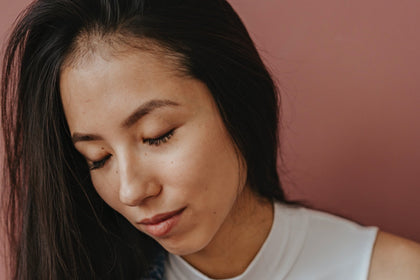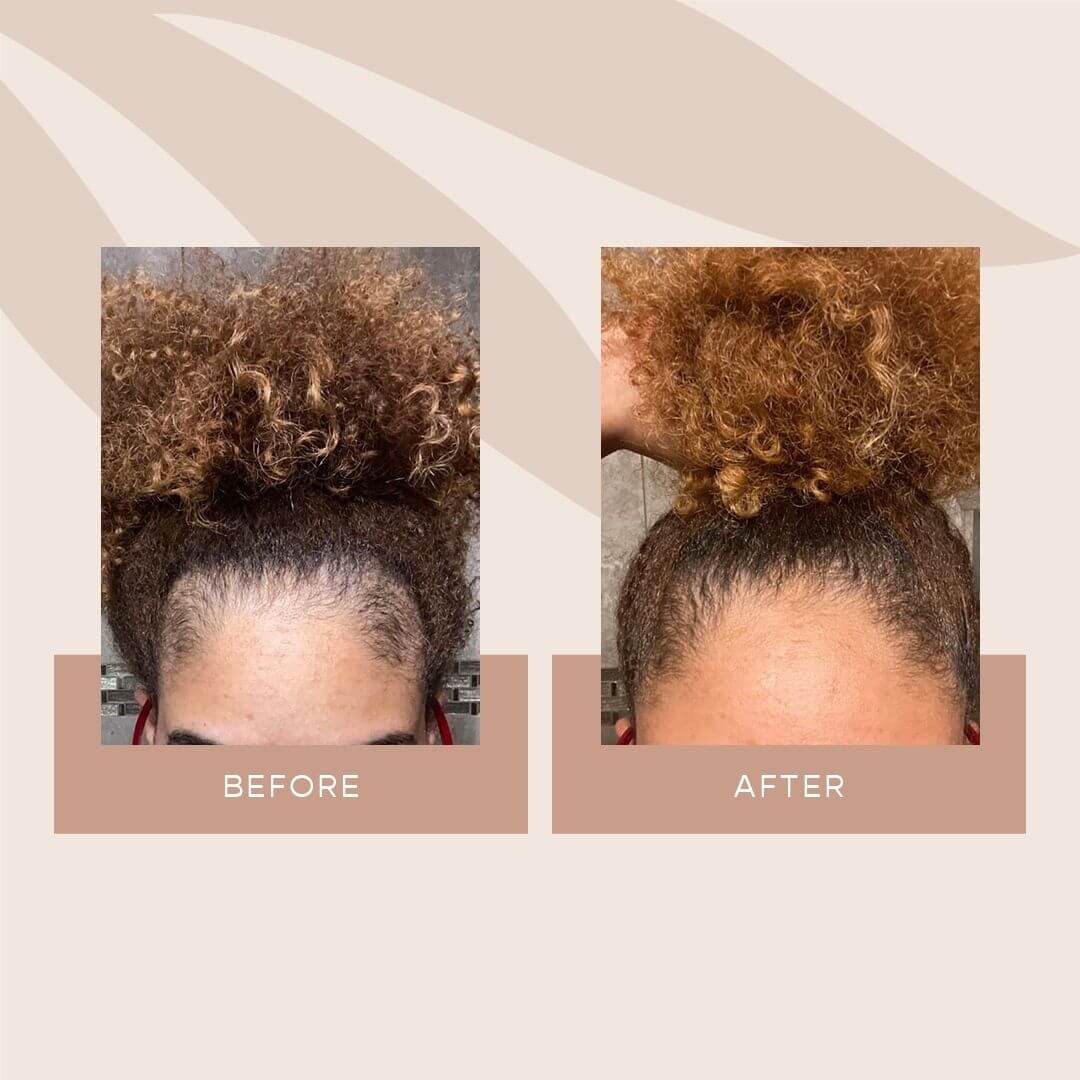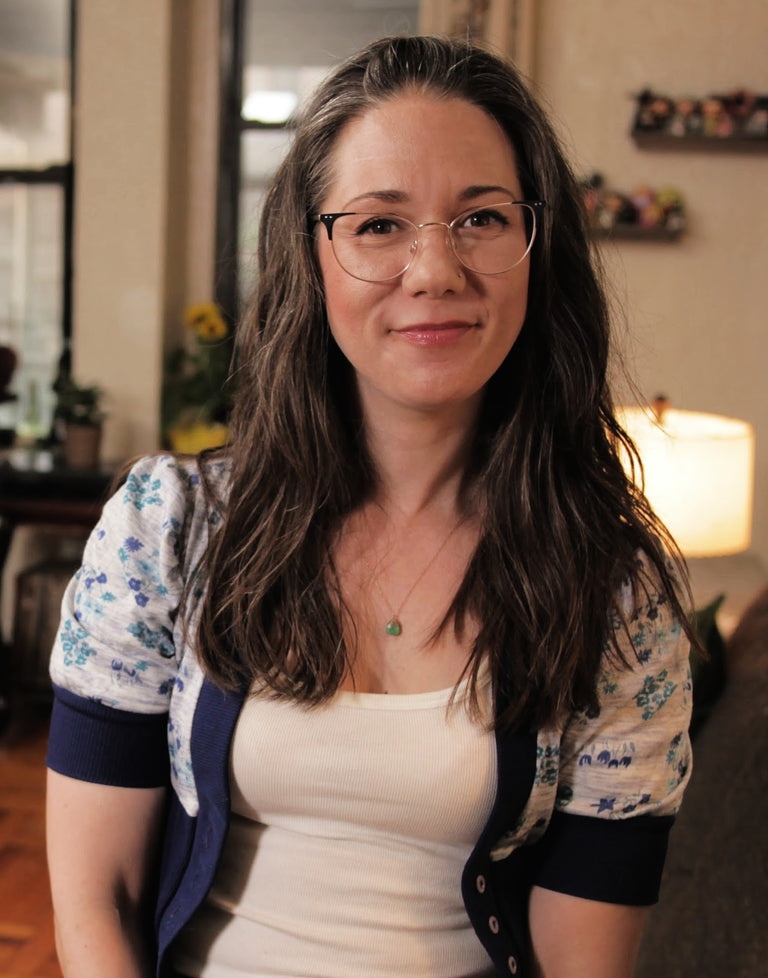Historically, female hair loss is a topic that has gotten less attention than male hair loss, but that doesn’t mean it doesn’t happen! Lost hair is troubling, regardless of sex or gender, and hair loss can come in many shapes and sizes.
Thinning at the temples is one such presentation of hair loss, and since your temples are a prominent part of your hairline, hair loss there can be particularly stressful. Stay tuned for what causes female hair loss in this area, along with what you can do to combat thinning temple hair ASAP.
Causes of Temporal Hair Loss
Factors causing hair loss at the temples could include an underlying medical condition, genetics, environmental stressors, lifestyle or even hairstyling.
“Traction alopecia, androgenic hair loss (which can be associated with polycystic ovarian syndrome), diffuse alopecia areata, telogen effluvium and front fibrosing alopecia are the most common causes of temporal hair loss in women,” explained Dr. Taraneh Nazem, a board-certified OB-GYN and endocrinology specialist with RMA of New York.
In other words: hair loss is complex and is most often a symptom rather than a condition in and of itself. But the good news is, much of the time, hair loss at the temples is temporary and can be treated.
“Many of these conditions are associated with stress or an underlying illness, deficiency or infection and therefore are treatable and reversible,” added Dr. Nazem.
#include-related-slider#
Traction Alopecia
Traction alopecia is hair fall that results from repeated and prolonged pulling on the hair. TA is most often due to hairstyling, such as extensions, weaves, tight ponytails, tight braids and tight buns.
Tight pulling is tough on hair follicles because it constricts blood circulation. Repeated stress on the follicles makes it harder for them to hold on to the hair shafts, which leads to increased hair shedding. Traction alopecia can happen anywhere on the scalp, including at the temples.
“Traction alopecia can present as temple recession if the pull is strongest on the hairs of the temple region,” explained Dr. Hootan Zandifar, a hair transplant and plastic surgeon. So if your hairstyling is causing soreness or tenderness in and around your temples, it’s a sign your follicles are not happy.
The easiest way to reverse temple thinning from traction alopecia is to pamper your follicles with some TLC. Also, it's important to take a break from the offending styling techniques until your hair is fully grown back. But it's an even better idea to permanently ditch tight hairstyles.
“While it may be reversible at first, persistent trauma can lead to scarring and irreversible hair loss,” warned Dr. Daniel P. Friedmann, board-certified dermatologist with Westlake Dermatology.
Androgenetic Alopecia
You might already be familiar with androgenetic alopecia because it’s the underlying cause for what we know as male pattern balding. However, it’s also the underlying cause of female pattern hair loss, also known as female pattern balding.
Androgenetic alopecia, also sometimes called androgenic alopecia, happens most often in people with a family history of pattern balding. In other words, it’s genetic. “Usually, you’ll see temporal hair loss with any genetic precursor, as in the case of androgenetic alopecia,” shared Jonesia Melton-Hegwood, a board-certified trichologist and owner of Salon J’Lynae.
Hair shedding with androgenetic alopecia is usually not dramatic hair loss. Instead, it typically comes on slowly and is characterized by a gradual thinning that could eventually lead to a receding hairline. It’s still not well understood, though researchers have uncovered that it is linked to a family of hormones called androgens (hence the name).
Female pattern baldness typically causes thinning at the crown of the head, but it can also cause thinning at the temples. “Temple recession is a very common presentation in men; however, it is less common in women," said Dr. Zandifar. "Women who suffer from androgenetic alopecia related to testosterone hormone can, at times, present with predominant temple recession."
Shop: Clean Hair Products
PCOS And Other Endocrine Disorders
Polycystic ovary syndrome (PCOS) is a condition that causes cysts to develop on the ovaries, involving hormonal imbalances, weight gain, missed periods and maybe even hair loss.
PCOS is an endocrine disorder. The endocrine system is responsible for hormone production, which are chemical signals that travel throughout the body to regulate a whole host of functions. Endocrine disorders can therefore cause a variety of health issues that are related to hormones, and PCOS often occurs alongside thyroid problems or disruptions to the immune system.
One study suggests that there is a strong connection between PCOS and female hair loss, most often resulting in thinning at the temples, thinning hair around the crown and diffuse thinning over the entire scalp.
#include-related-slider#
Alopecia Areata
Alopecia areata, or AA, is a form of hair loss that is caused by an autoimmune disorder. It’s easier to identify than other forms of alopecia since the distinctive hair loss caused by AA are round, coin-sized bald patches that can happen on the head or anywhere else on the body.
Though the condition is still not well understood, it’s believed that the bald spots caused by AA are a result of the person’s immune system mistakenly attacking hair follicles. Luckily, many who experience patchy hair loss caused by AA are otherwise healthy and may not experience other symptoms.
The patchy hair loss associated with AA can happen anywhere on the scalp, though thinning at the temples seems to happen more frequently via a rare form of the condition called diffuse alopecia areata. It’s most common among young women and is characterized by sudden thinning that happens over the entire scalp.
Postpartum Hair Loss And Telogen Effluvium
Women who experience hair loss after giving birth (postpartum) often notice thinning hair at the temples along with an overall thinning of their entire scalp. Postpartum hair loss is a form of temporary hair loss condition called telogen effluvium or TE. People who experience TE will notice a sudden and seemingly drastic increase in hair shedding. However, it’s typically a temporary form of hair loss that resolves on its own.
“The temples are a very common area for hair loss associated with telogen effluvium, which is a hair loss disorder that is a common postpartum occurrence in women. There is a diffuse pattern of hair loss a few months after giving birth, but it is most evident in the bi-temporal region,” explained Dr. Nazem.
A major shock to the body is what causes telogen effluvium in the first place. This trigger can come from any number of sources, including physical or emotional stress, a severe illness like the flu or COVID-19, medications and giving birth.
Telogen effluvium happens because the shock to the body effectively disrupts the normal hair growth cycle by pushing an unnaturally high number of follicles into the resting, or telogen, phase of their cycle. The next phase, the shedding phase, is when you’ll see an increased hair shed. But by that point, your body is already moving back to the active growth phase.
Discover: Here’s What You Can Do About Postpartum Hair Loss
Frontal Fibrosing Alopecia
Frontal fibrosing alopecia is a rare inflammatory skin disease affecting the scalp and hair. It is not well understood, though it is hypothesized that it is an autoimmune condition. People who have frontal fibrosing alopecia typically experience slow and progressive hair thinning and scarring in and around the forehead.
“Frontal fibrosing alopecia is a less common condition and a form of scarring alopecia. It is sometimes associated with eyebrow loss as well as hair loss on the scalp and temples,” explained Dr. Nazem.
Since this condition is a scarring form of hair loss, follicles are often permanently damaged, and hair cannot be regrown in the affected areas.
Addressing Temporal Hair Thinning
"I started to lose all my edges. It was literally just falling out, hair was everywhere and my scalp hurt," said Ayla Espinal, who experienced postpartum hair loss. "I decided to take a chance and ask for recommendations on hair growth products on Instagram and a good friend of mine (who also has curly hairy which is so important to me) recommended VEGAMOUR. I went ahead and gave it a try and HONEY!!!!! Thank God I did. I got the GRO+ Advanced Hair Serum and have been on it for about two months now. It’s the only thing I have used and will continue to use. Not only did my edges grow back, my hair was healthier and my curls looked soooooo good! I have not only seen my hair grow (from literally being bald) but my hair is so much thicker, my curls are alive, and I have less shedding and hair loss."
When To Seek Professional Medical Advice
If you’re seeing noticeable thinning at your temples and are at a loss for a reason, your best bet is to see a doctor. As there are many possible causes for thinning temple hair, a trained professional is best equipped to help you figure out the root cause.
“Hair loss at the temples and frontal scalp is extremely common and may be associated with several forms of hair loss," said Dr. Anna Chacon, board-certified dermatologist and founder of My Psoriasis Team. "It is best to seek an in-office visit with a dermatologist for further evaluation and management. Various tools may be used to confirm the diagnosis, including blood tests, trichograms, [a] hair pull test, trichoscopy and even a biopsy if necessary,” she added.
What You Can Do to Prevent And Treat Hair Loss
Often, the first step to treat troubling hair loss and prevent future shedding is to see a dermatologist or trichologist to identify and treat the underlying cause(s). However, here are a few tips you can implement on your own to help support healthy hair growth from the inside and out.
1. Be Gentle and Add Some TLC
If you’re suffering from traction alopecia, you probably already know that tight hairstyles are a no-go.
“To prevent hair loss at the temporal area, don’t wear tight ponytails, avoid excessive brushing and product application to your edges, and be sure to use a soft brush on edges to prevent damage,” said Melton-Hegwood.
Also, avoid treatments and styling techniques that can damage hair, such as heated styling tools, relaxers or other chemical treatments.

2. Maintain a Healthy Diet
“Poor nutrition helped me grow thick and luxurious hair,” said no one ever.
In fact, nutritional deficiencies can actually make hair loss worse. Biotin, zinc and iron deficiency (among others) have been tied to hair loss, so be sure to eat a balanced diet and supplement as needed to be sure you’re giving your body all it needs to grow healthy hair.

Try a gummy vitamin that supports healthy hair. Just one gummy per day will provide you with a host of hair-friendly vitamins and minerals, including vitamins A, C, E and B6, along with zinc, folic acid and biotin.
3. Manage Stress
Stressing about hair loss can actually make hair loss worse because stress can have major impacts on your hair and on your general health.
Consider adding proactive stress management activities to your repertoire like meditation, yoga, spending time with animals and in nature, and making sure you get enough sleep — all science-backed ways to help reduce stress.
The Lowdown: Everything You Need to Know About Stress and Hair Loss
4. Be Patient
“It is important to note that it takes time for hair to regenerate,” said Dr. Nazem. So be patient! On average, hair grows about ½ inch per month, so it will take a few months to really see hair coming back.
The Takeaway
Many different factors cause hair loss. And the best way to treat temple hair loss is by identifying the underlying cause, addressing it and supporting the healthy regrowth of temple hair with a healthy diet and lifestyle. Take good care of your hair follicles and be patient!
#include-related-slider#
More From VEGAMOUR
- Shop: Shea Whitney's Favorite VEGAMOUR Products
- Do Split Ends Stop Hair Growth?
- Can a Breakup Cause Hair Loss?
- How Long Does Postpartum Hair Loss Last?
Photo credit: olia danilevich/Pexels
Back



















